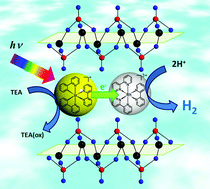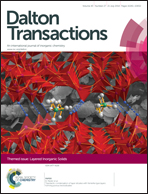Visible-light driven H2 production utilizing iridium and rhodium complexes intercalated into a zirconium phosphate layered matrix
Abstract
Intercalation of photosensitizer cyclometalated iridium(III) ([Ir(ppy)2(bpy)]BF6) and proton reduction catalyst tris-2,2′-bipyridyl rhodium(III) ([Rh(bpy)3](BF6)3) complexes into a layered zirconium phosphate (ZrP) with an interlayer distance of 10.3 Å has been attained with the aim of developing a visible-light responsible photocatalyst for H2 production in aqueous media. Ir LIII-edge and Rh K-edge X-ray absorption fine structure (XAFS) measurement indicates that both Ir and Rh complexes are intercalated into the layered interspace without structural change around metal environments. The photoluminescence emission of the exchanged Ir complex due to a triplet ligand-to-ligand charge transfer (3LLCT) and a metal-to-ligand charge-transfer (3MLCT) transition near 560 nm decreases with increasing the amount of adjacent Rh complexes, suggesting the occurrence of electron transfer from Ir complex to Rh complex. The Ir–Rh/ZrP catalyst exhibits both visible-light sensitization and H2 production from aqueous solution in the absence of an electron mediator. The photocatalytic activities are strongly dependent on the ratio of the components, and the maximum activity can be attained with a molar ratio of Ir : Rh = 10 : 1.

- This article is part of the themed collection: Layered Inorganic Solids

 Please wait while we load your content...
Please wait while we load your content...